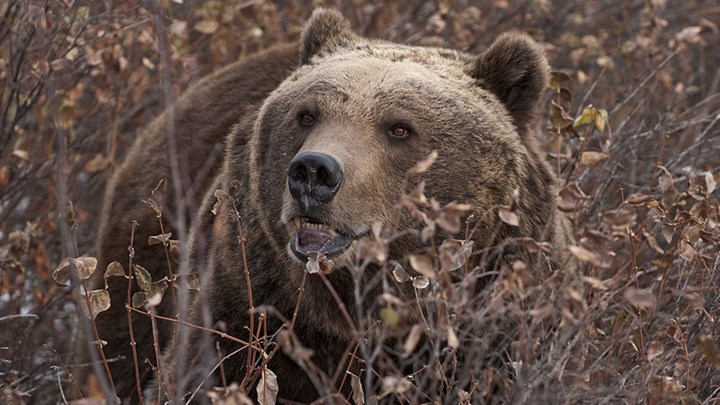
by Tim Irwin - Friday, October 19, 2018

Folks in other parts of the country call this neck of the woods the Greater Yellowstone Ecosystem (GYE). It’s basically vast blocks of federal land in Montana, Idaho and Wyoming that surround Yellowstone National Park. To those of us lucky enough to live in this corner of the Rocky Mountain West, it’s simply home.
Most of my neighbors are disappointed but not surprised by the recent federal judicial ruling by Federal U.S. District Judge Dana Christensen stuffing the grizzly back on the Endangered Species List. Actually, we’re kinda used it.
Animal rights extremists have a long history of trying to foist their dogma on wildlife management here. They shop for the right judge, distort the facts and drag in all the “warm and fuzzy” they can muster. They don’t always get exactly what they want, but they surely gum things up.
For decades there’s been a battle over bison. Then over wolves. Lately the fight has been about bears.
Much of the bear debate is a case of perspective versus reality. From their suburban nests in New Jersey, one side visualizes a Rocky Mountain Eden, where herds of grizzlies roam the ridges as howling packs of wolves serenade them in the background. They imagine capturing it all in a single, iPhone panoramic, out the window of their Prius.
The reality is something different.
Those of us who live here understand the grizzly has nearly maxed out the available habitat. Bears are showing up in places they haven’t been seen in over a century—the treeless prairie. Sheep kills by grizzlies have become a common occurrence in the grassy ranchlands east of Montana’s Rocky Mountain Front. Even pheasant hunters hiking the rolling seas of grass in this region now have to be cautious.
The fantasy is that there’s room for lots more bears. That’s simply not true. Grizzlies are creatures of true wilderness. There’s just not that much of it left, and it’s steadily shrinking.
Bozeman, Mont., on the edge of the GYE, has swollen from a quaint mountain town to a bloated suburb of cookie-cutter houses, mega motels and strip malls. In the last 20 years, its population has more than doubled to 46,000. You can imagine the pressure that growth puts on the wild lands that surround it.
Fifty miles south, hard up against the Lee Metcalf Wilderness and enveloped by national forest, sits Big Sky. Developers refer to it as the new Aspen. They say the resort has the most vertical feet of skiing in all of North America. With that comes tourist condos and vacation mansions for the uber rich. Plans call for lots, lots more of them. That can’t be good for grizzlies.
Grizzly-human conflicts are on the rise. Bear encounters are becoming more frequent. No surprises here. Recently, as this website reported, a Wyoming guide was attacked and killed by a grizzly.
In many corners of the GYE, bears regard the sound of a rifle shot as a dinner bell, which means hunters have to be on their guard. Most of my neighbors who frequent the backcountry pack a Glock 20 as a matter of necessity. Nobody hikes without bear spray.
It’s worth noting that a recurrent theme in many of the recent bear encounter stories is how little the bear seemed to fear humans. It seems that after a couple generations of not getting shot at, grizzlies in this neighborhood have chips on their shoulders. That is concerning.
Not that we’re complaining. We get that it’s the grizzlies that make wild country wild. Where we live would not be the same without them. So we adapt. We pack firepower and pay attention when traversing bear country. We also recognize the bears need to be managed.
There is no more awe-inspiring scene than a grizzly bear in the wild. It is a symbol of all that is wild in the West. Just a glance from him ignites a feeling in your core that maybe you aren’t at the top of the food chain. And you rapidly gain more respect for the professionals who manage bears.
Therein lies the point.
The best most of us who share these mountains with elk, deer, bears and buffalo hope for is that wildlife be managed by professional wildlife managers, not judges and politicians. Bringing the grizzly populations back is one of the great conservation successes of the last 100 years. A whole batch of biologists and wildlife managers made careers of bringing the great bears back from the brink. They know their stuff.
Most wildlife professionals agree the grizzly population has reached a tipping point and that the best way to preserve them isn’t complete protection. Instead of applauding wildlife managers for their successes, Federal U.S. District Judge Dana Christensen has seen fit to ignore them. Doing nothing is not managing. Doing nothing can lead only to more problems. The ruling prompts another gut feeling, a pain that comes from knowing the system has been scammed and wildlife has been shortchanged again. It’s something we will never get used to.
About the Author: Tim Irwin photographs wildlife and writes about hunting, conservation and the outdoors from his home in Cameron, Mont. That’s about 50 miles, as the crow flies, from Yellowstone National Park and the heart of grizzly country.
Editor’s Note: The NRA played a major role in defending the proposed 2018 grizzly bear hunts in the Greater Yellowstone Ecosystem in court and will continue to monitor the issue. As the author points out, not only did the judge’s decision sidestep the fact that GYE grizzly bears mark one of the greatest conservation comebacks in American history, but it was made despite that the region’s grizzly populations—and human-grizzly conflicts—continue to escalate.
E-mail your comments/questions about this site to:
[email protected]
